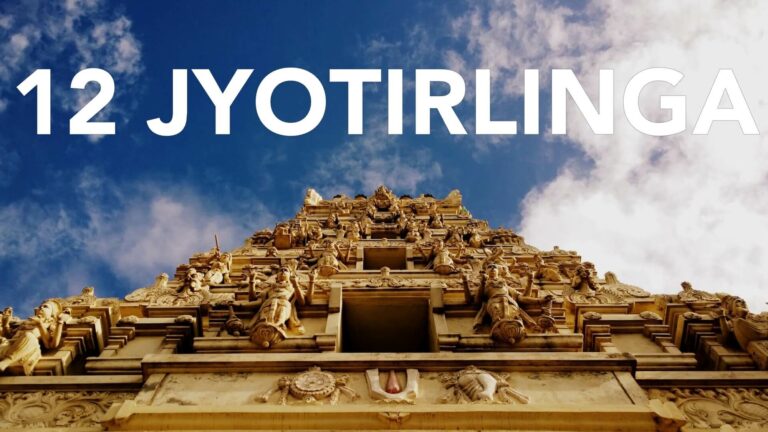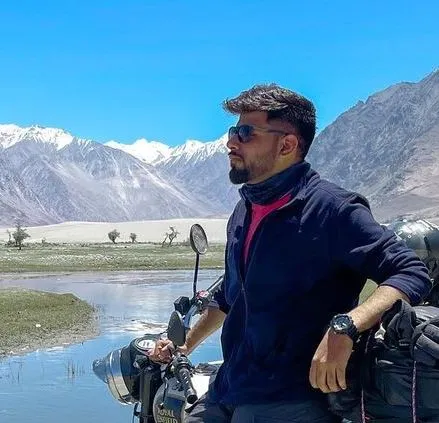Lord Shiva is one of the most revered deities in Hinduism. He is worshipped in various forms and names, but one of the most sacred and powerful ways to connect with him is through the 12 Jyotirlinga. These are the luminous pillars of light that emerged from the earth and reached the sky, representing Shiva’s supreme presence and power.
The 12 Jyotirlinga are located in different parts of India, each with its own history and significance. They are not only places of worship, but also sources of spiritual enlightenment and bliss. Millions of devotees visit these shrines every year, especially during festivals like Maha Shivaratri, to seek Shiva’s blessings and grace.
If you are a spiritual seeker or a curious traveler, you should not miss the opportunity to explore these 12 Jyotirlinga and experience their divine radiance. In this blog post, we will give you a brief overview of each Jyotirlinga, its location, architecture, legend, and how to reach there.
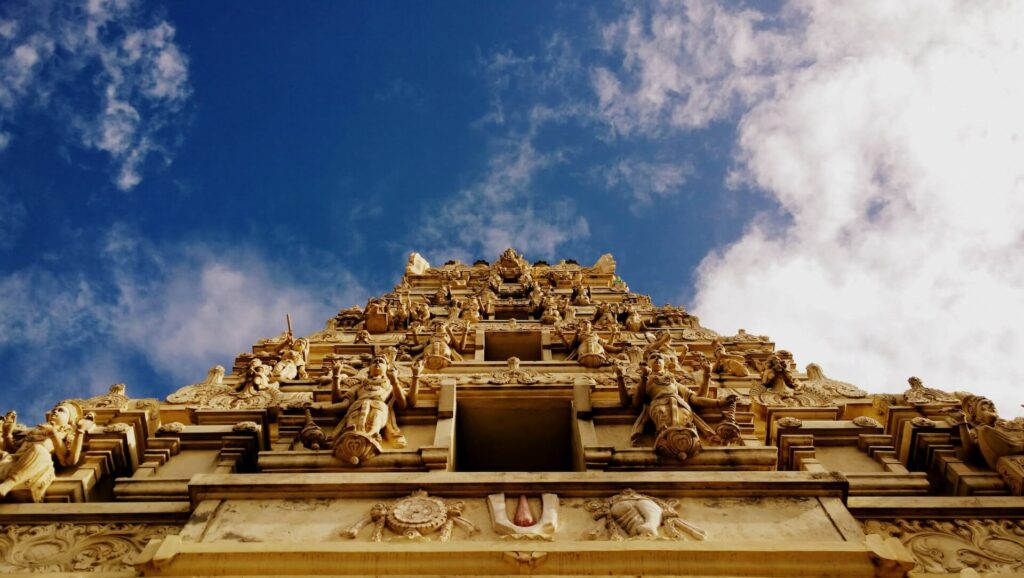
Somnath: The First Jyotirlinga
Somnath is considered as the first and foremost Jyotirlinga in India. It is situated on the coast of Saurashtra in Gujarat. According to legend, Lord Shiva appeared here as a fiery column of light to bless the moon god Chandra, who was cursed by his father-in-law Daksha for favoring only one of his 27 wives, Rohini. Shiva restored Chandra’s beauty and glory and stayed here as Somnath, meaning “Lord of the Moon”.
The Somnath temple is a magnificent structure with a Chalukyan style of architecture. It has been destroyed and rebuilt several times by invaders and rulers, but its sanctity remains intact. The temple has a stunning view of the Arabian Sea and a spectacular light and sound show every evening.
To visit Somnath, you can take a train or a flight to Veraval, which is the nearest railway station and airport. From there, you can hire a taxi or a cab to reach Somnath, which is about 5 km away.
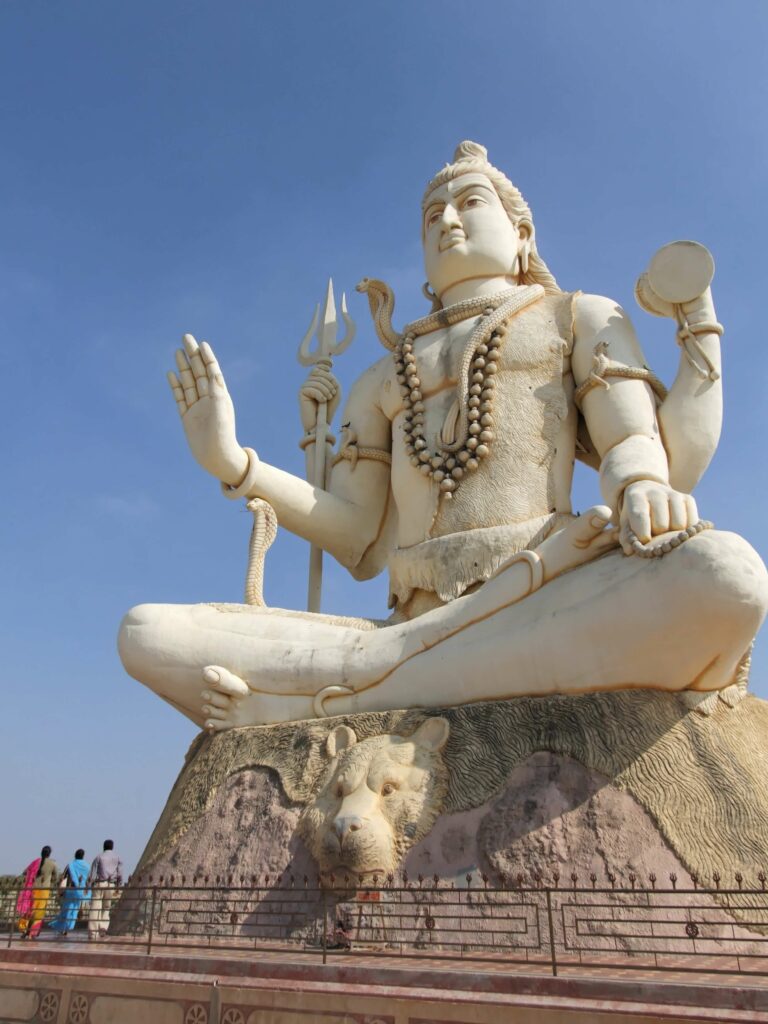
Nageshwar: The Protector from Snakes
Nageshwar is another Jyotirlinga located in Gujarat, near Dwarka. It is also known as Nagnath or Nageshwara. It is believed that Lord Shiva appeared here as a giant snake to save his devotees from a demon named Daruka, who had captured them and taken them to his underwater city. Shiva killed Daruka and his army of snakes and stayed here as Nageshwar, meaning “Lord of Snakes”.
The Nageshwar temple is surrounded by a beautiful garden and overlooks the blue waters of the Arabian Sea. The main attraction of the temple is a 25-meter tall statue of Lord Shiva, which is visible from a distance. The temple also has a shrine dedicated to Goddess Parvati, who is worshipped here as Kamalaja.
To reach Nageshwar, you can take a train or a flight to Jamnagar, which is the nearest airport and railway station. From there, you can take a bus or a taxi to Dwarka, which is about 45 km away. From Dwarka, you can hire an auto or a cab to reach Nageshwar, which is about 12 km away.
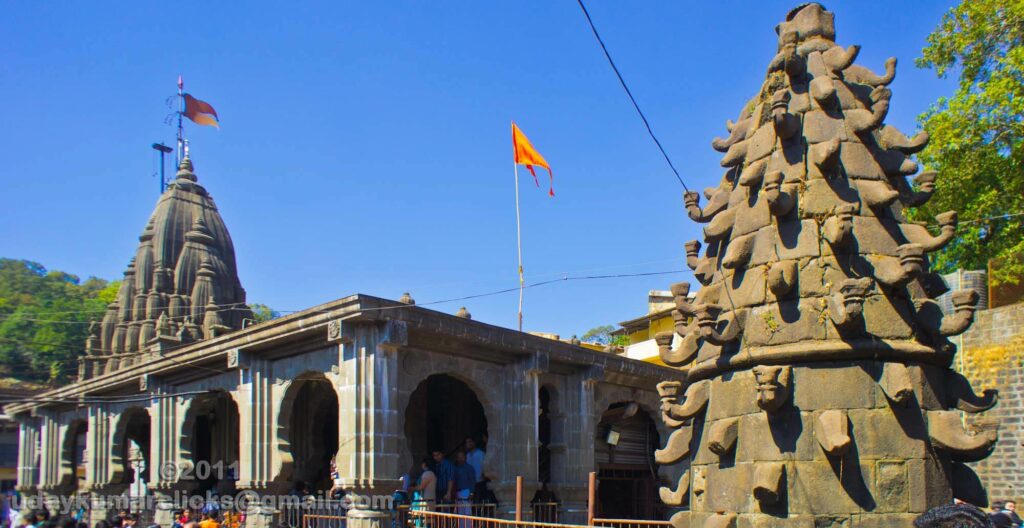
Bhimashankar: The Abode of Bheema
Bhimashankar is one of the Jyotirlinga located in Maharashtra, near Pune. It is said that Lord Shiva appeared here as Bhimashankar to kill an evil demon named Tripurasura, who had terrorized the three worlds with his three flying cities. Shiva destroyed Tripurasura’s cities with his arrow and stayed here as Bhimashankar, meaning “Lord of Bheema”. Bheema was the son of Kumbhakarna, Ravana’s brother.
The Bhimashankar temple is built on a black rock hill in Nagara style of architecture. It is surrounded by a dense forest reserve that houses many rare species of flora and fauna. The temple also has a sacred pond called Kund and a waterfall called Bhimarathi. Devotees flock to this temple during Maha Shivaratri and other festivals.
To visit Bhimashankar, you can take a train or a flight to Pune, which is the nearest airport and railway station. From there, you can take a bus or a taxi to Bhimashankar, which is about 110 km away.
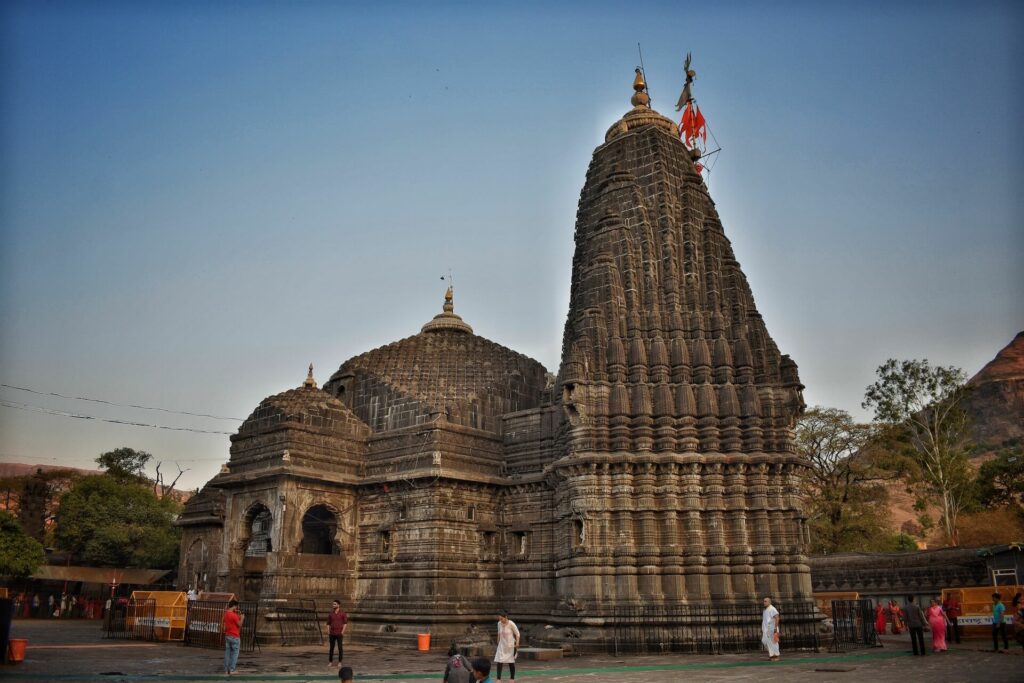
Trimbakeshwar: The Source of Godavari
Trimbakeshwar is another Jyotirlinga situated in Maharashtra, near Nashik. It is located at the foot of the Brahmagiri mountain, which is the origin of the Godavari river, also known as Gautami Ganga. According to legend, Lord Shiva appeared here as Trimbakeshwar to calm down the anger of Sage Gautam, who had accidentally killed a cow and was cursed by other sages. Shiva also blessed Gautam and his wife Ahalya with a son named Shatanand.
The Trimbakeshwar temple is a unique Jyotirlinga, as it has three faces representing Brahma, Vishnu, and Shiva. The faces are covered with a silver crown adorned with precious stones. The temple also has a pit where the Godavari river emerges and flows. The temple is visited by pilgrims who perform rituals like Kumbh Mela, Narayan Nagbali, and Tripindi Shraddha.
To reach Trimbakeshwar, you can take a train or a flight to Nashik, which is the nearest airport and railway station. From there, you can take a bus or a taxi to Trimbakeshwar, which is about 30 km away.
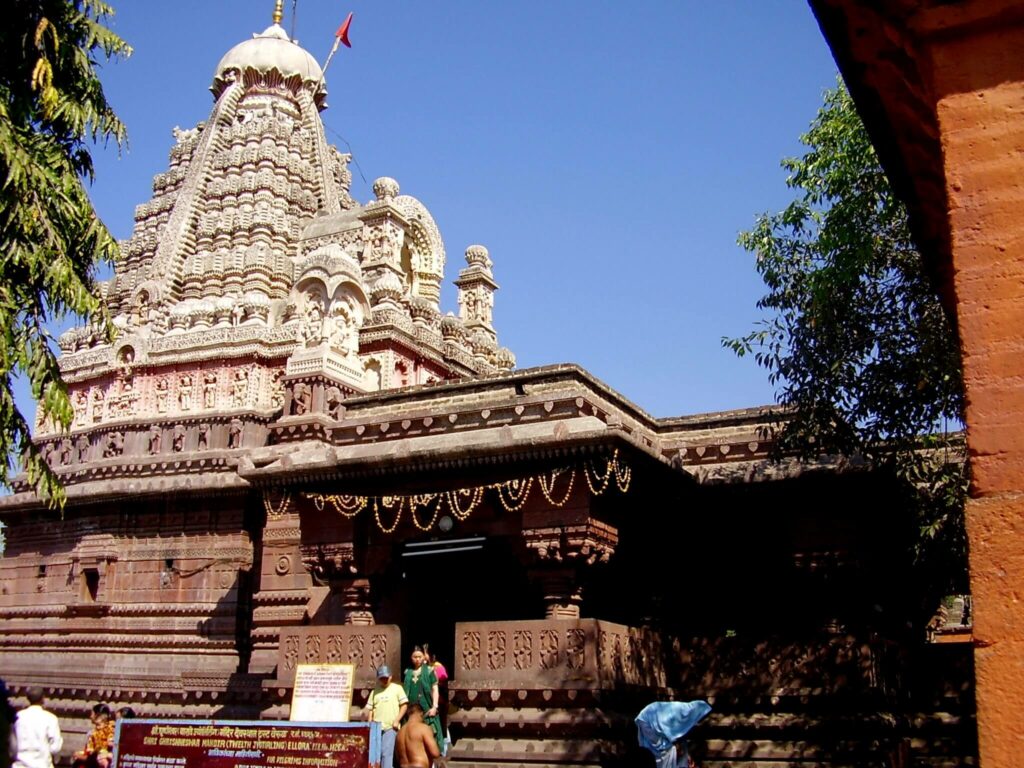
Grishneshwar: The Last Jyotirlinga
Grishneshwar is the last Jyotirlinga in India. It is located near Aurangabad in Maharashtra, close to the famous Ajanta and Ellora caves. It is also known as Ghrushneshwar or Kusumeshwar. It is believed that Lord Shiva appeared here as Grishneshwar to fulfill the wish of a devout woman named Kusuma, who had lost her son due to her husband’s second wife. Shiva restored Kusuma’s son and stayed here as Grishneshwar, meaning “Lord of Compassion”.
The Grishneshwar temple is a splendid structure with red rock walls and intricate carvings. It has five tiers of shikharas or spires and a huge Nandi bull in the hall. The temple also has a statue of Vishnu’s Dashavatar or ten incarnations on the red rock wall. The temple is one of the 52 Shakti Peethas of Goddess Parvati, who is worshipped here as Kamalaja.
To visit Grishneshwar, you can take a train or a flight to Aurangabad, which is the nearest airport and railway station. From there, you can take a bus or a taxi to Grishneshwar, which is about 30 km away.
Vaidyanath: The Healer of All Ills
Vaidyanath is one of the Jyotirlinga located in Jharkhand, near Deoghar. It is also known as Baidyanath or Vaijinath. It is one of the 52 Shakti Peethas of Goddess Parvati, who is worshipped here as Jai Durga. The legend behind this Jyotirlinga is that Lord Rama worshipped Shiva here after killing Ravana and asked him to come to Lanka with him. Shiva agreed but told Rama not to keep the linga down anywhere on the way. However, Rama was tricked by Vishnu and kept the linga down at this place. Thus, Shiva remained here as Vaidyanath, meaning “Lord of Physicians”.
The Vaidyanath temple is an ancient structure with a dome-shaped roof and carved pillars. It has 21 other temples within its complex dedicated to various deities like Ganesha, Parvati, Hanuman, and Kalabhairava. The temple attracts lakhs of devotees during the month of Shravan, who carry holy water from Ganga river to offer to the linga.
To reach Vaidyanath, you can take a train or a flight to Ranchi, which is the nearest airport and railway station. From there, you can take a bus or a taxi to Jasidih Junction, which is about 7 km away from Vaidyanath.
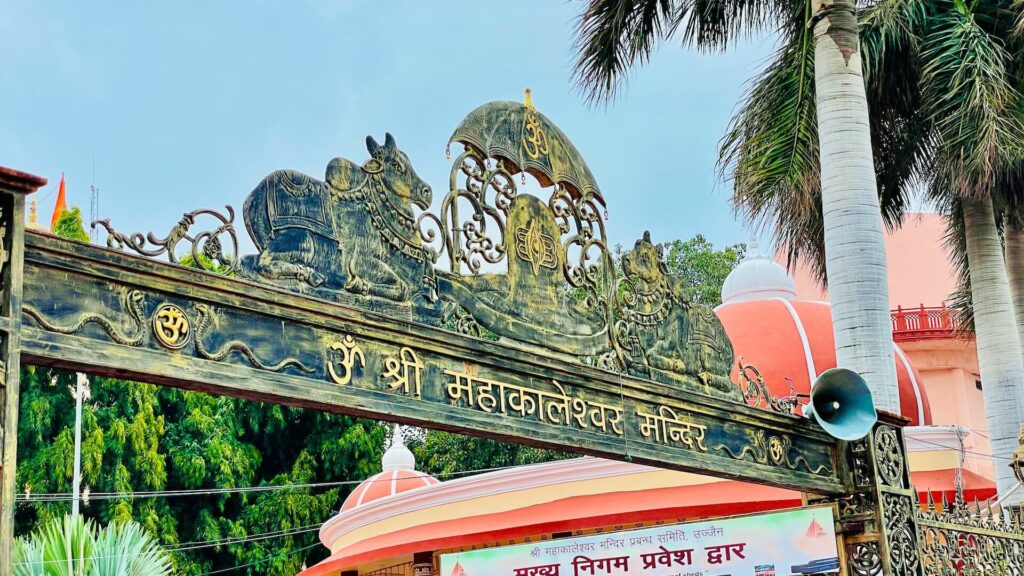
Mahakaleshwar: The Lord of Time
Mahakaleshwar is one of the Jyotirlinga located in Madhya Pradesh, in the city of Ujjain. It is also one of the seven Mukti Sthalas or places of liberation in India. It is said that Lord Shiva appeared here as Mahakaleshwar to protect his devotee King Chandrasena from an enemy king named Ripudaman. Shiva killed Ripudaman and his army with his trident and stayed here as Mahakaleshwar, meaning “Lord of Time”.
The Mahakaleshwar temple is a majestic structure with a three-storeyed shikhara or spire. The temple has a huge silver-plated Nandi bull and a golden flag on the top. The temple also has a sacred tank called Koti Tirtha, where devotees take a dip before entering the temple. The temple is famous for its Bhasma Aarti, which is performed every morning with the ashes of a funeral pyre.
To visit Mahakaleshwar, you can take a train or a flight to Indore, which is the nearest airport and railway station. From there, you can take a bus or a taxi to Ujjain, which is about 55 km away.
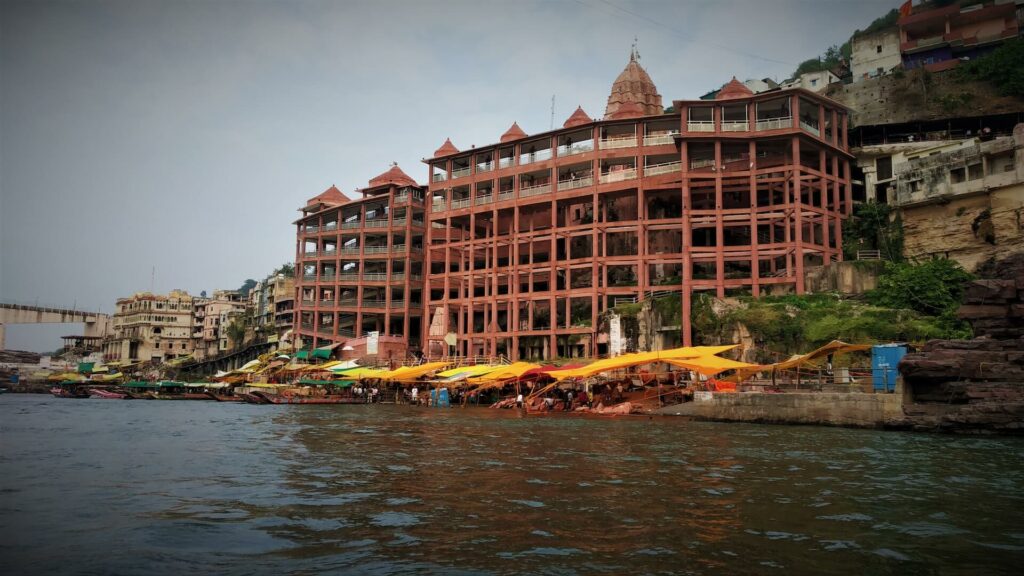
Omkareshwar: The Om-Shaped Island
Omkareshwar is another Jyotirlinga situated in Madhya Pradesh, on an island called Mandhata in the Narmada river. The island is shaped like the sacred symbol of Om, hence the name Omkareshwar. It is also known as Amareshwar or Mamleshwar. It is believed that Lord Shiva appeared here as Omkareshwar to bless King Mandhata, who was a great devotee of Shiva. Shiva also granted a boon to the sage Narada, who had meditated here for a long time.
The Omkareshwar temple is a beautiful structure with a Nagara style of architecture. It has a dome-shaped roof and four entrances facing different directions. The temple also has a shrine dedicated to Goddess Parvati, who is worshipped here as Annapurna. The temple is located on the south bank of the island, while another temple called Mamleshwar is located on the north bank. Both are considered as Jyotirlinga.
To reach Omkareshwar, you can take a train or a flight to Indore, which is the nearest airport and railway station. From there, you can take a bus or a taxi to Omkareshwar, which is about 80 km away.
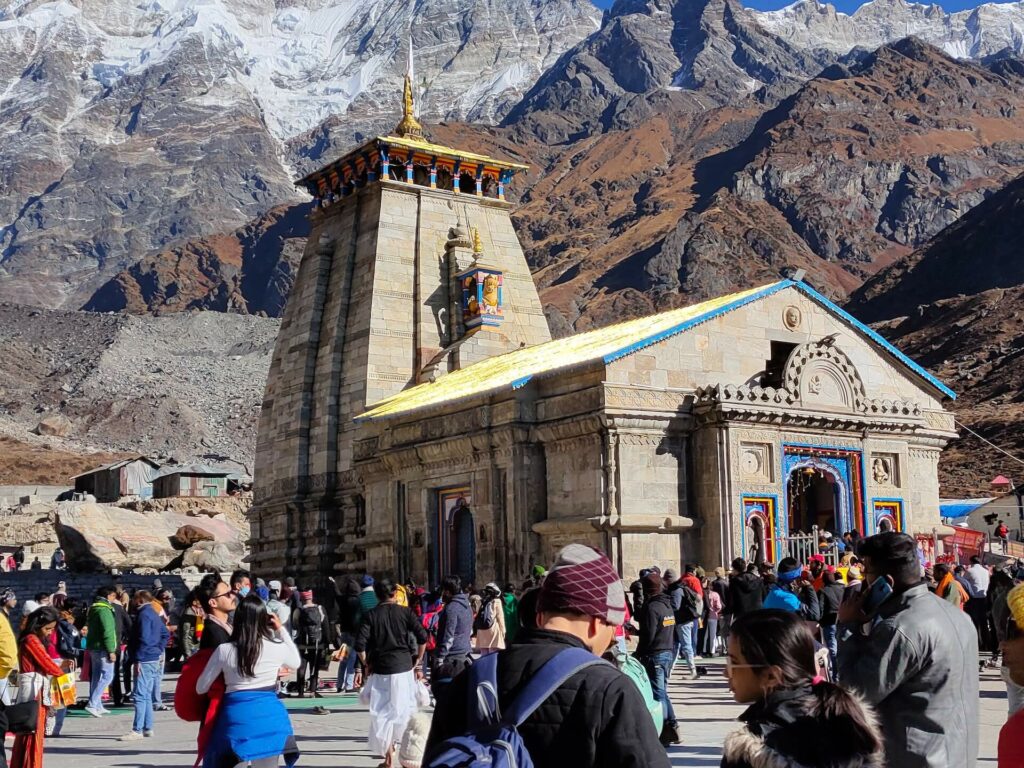
Kedarnath: The Abode of Kedar
Kedarnath is one of the 12 Jyotirlinga located in Uttarakhand, in the Himalayan range. It is also one of the four Char Dhams or holy destinations in India. It is said that Lord Shiva appeared here as Kedarnath to evade the Pandavas, who were seeking his forgiveness for killing their cousins in the Kurukshetra war. Shiva disguised himself as a bull and hid among other cattle, but was recognized by Bhima, who tried to catch him. Shiva’s body parts emerged at different places, forming the Panch Kedar or five Kedars. His hump remained at Kedarnath.
The Kedarnath temple is an ancient structure made of stone and wood. It has a conical roof and a large hall with statues of various deities. The temple also has a Garbhagriha or sanctum sanctorum, where the linga is installed. The temple is situated at an altitude of 3584 meters and is covered with snow for most of the year. The temple is open only from April to November and can be reached by trekking or helicopter.
To visit Kedarnath, you can take a train or a flight to Dehradun, which is the nearest airport and railway station. From there, you can take a bus or a taxi to Gaurikund, which is about 200 km away. From Gaurikund, you can trek for 16 km or take a helicopter to Kedarnath.
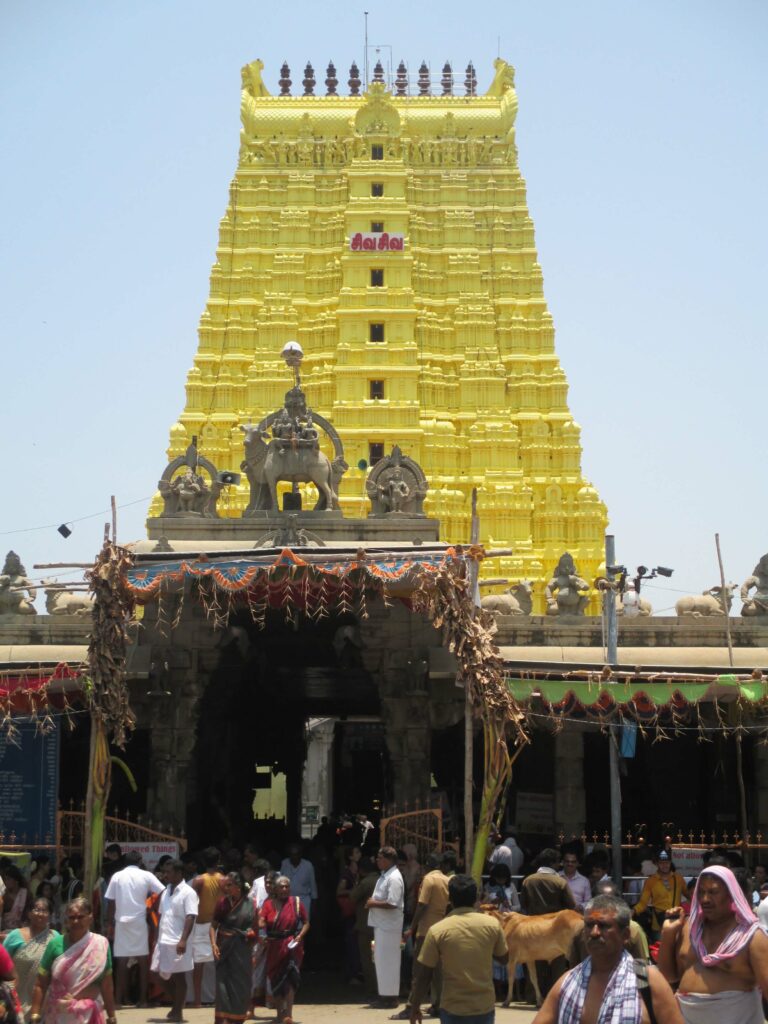
Rameshwaram: The Bridge to Lanka
Rameshwaram is one of the 12 Jyotirlinga located in Tamil Nadu, on an island in the Gulf of Mannar. It is also one of the four Char Dhams or holy destinations in India. It is said that Lord Shiva appeared here as Rameshwaram to bless Lord Rama, who had prayed to him before crossing the sea to Lanka to rescue his wife Sita from Ravana. Shiva also gave Rama his bow and arrow and asked him to install a linga here after his victory.
The Rameshwaram temple is a magnificent structure with Dravidian style of architecture. It has a long corridor with 1212 pillars and 22 wells that have holy water from different rivers. The temple also has a shrine dedicated to Goddess Parvati, who is worshipped here as Parvathavardhini. The temple is connected to the mainland by a bridge called Pamban Bridge, which was built by Rama’s army of monkeys.
To reach Rameshwaram, you can take a train or a flight to Madurai, which is the nearest airport and railway station. From there, you can take a bus or a taxi to Rameshwaram, which is about 170 km away.
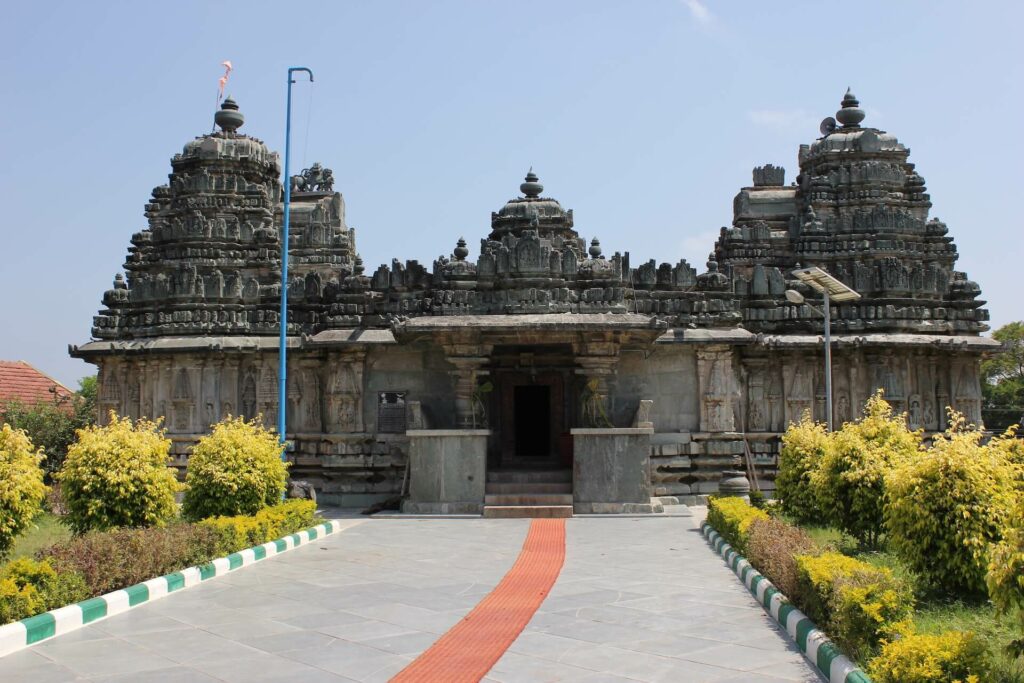
Mallikarjuna: The Lord of Jasmine
Mallikarjuna is one of the 12 Jyotirlinga located in Andhra Pradesh, on the banks of the Krishna river. It is also known as Srisailam or Shrishailam. It is said that Lord Shiva appeared here as Mallikarjuna to pacify his son Kartikeya, who had left Kailash after a quarrel with his parents over his marriage. Shiva and Parvati followed him and stayed here as Mallikarjuna and Bhramaramba, meaning “Lord of Jasmine” and “Lady of Bees”.
The Mallikarjuna temple is a splendid structure with a Vijayanagara style of architecture. It has a huge gopuram or tower and a mandapam or hall with intricate carvings. The temple also has a shrine dedicated to Goddess Parvati, who is worshipped here as Bhramaramba. The temple is one of the 18 Shakti Peethas of Goddess Parvati, where her neck fell when her body was cut by Vishnu’s discus.
To visit Mallikarjuna, you can take a train or a flight to Hyderabad, which is the nearest airport and railway station. From there, you can take a bus or a taxi to Srisailam, which is about 230 km away.
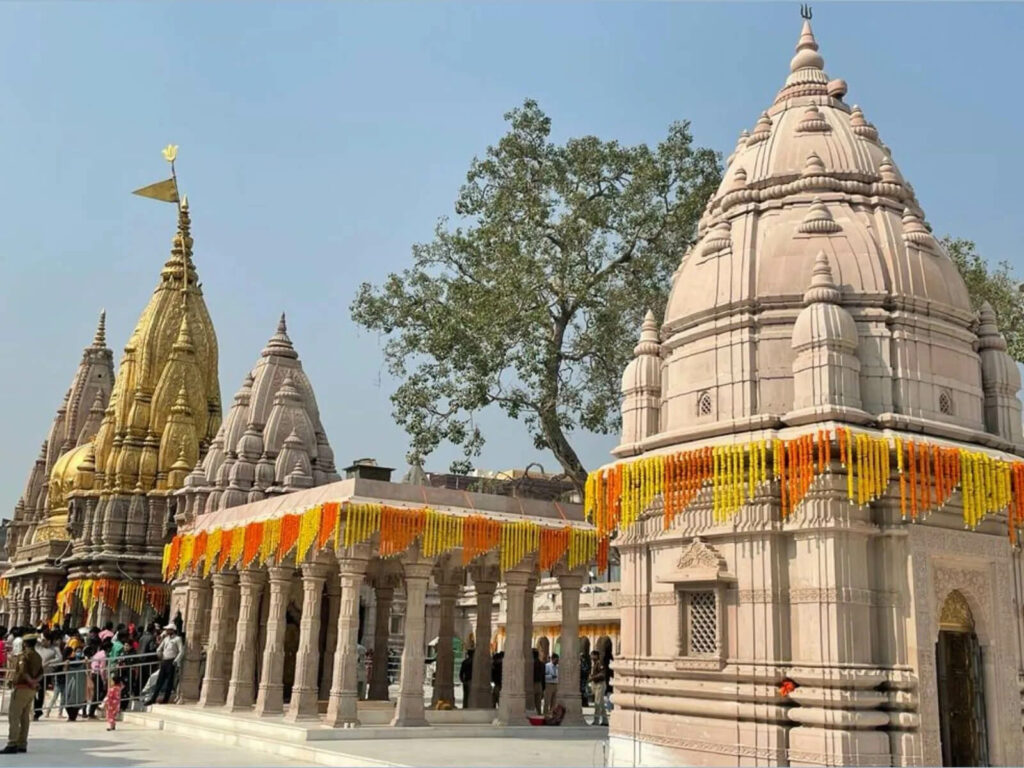
Vishwanath: The Lord of the Universe
Vishwanath is one of the 12 Jyotirlinga located in Uttar Pradesh, in the holy city of Varanasi. It is also known as Kashi Vishwanath or Banaras Vishwanath. It is said that Lord Shiva appeared here as Vishwanath to bless his devotee King Divodasa, who had built a magnificent city called Kashi. Shiva also granted a boon to the sage Markandeya, who had worshipped him here for a long time.
The Vishwanath temple is an ancient structure with a golden dome and spire. It has a silver-plated door and a marble floor. The temple also has a shrine dedicated to Goddess Parvati, who is worshipped here as Annapurna. The temple is one of the 12 Jyotir Lingas of Lord Shiva, where his light shines eternally.
To reach Vishwanath, you can take a train or a flight to Varanasi, which is the nearest airport and railway station. From there, you can take a rickshaw or a boat to reach the temple, which is located on the banks of the Ganga river.
Conclusion
The 12 Jyotirlinga are the divine manifestations of Lord Shiva that showcase his supreme power and presence in different parts of India. They are not only places of worship, but also sources of spiritual enlightenment and bliss. Each Jyotirlinga has its own history, legend, significance, and architecture that fascinate the devotees and travelers alike.
Visiting the 12 Jyotirlinga is a sacred pilgrimage for Hindus that can help them attain salvation and liberation from the cycle of birth and death. It can also help them fulfill their desires and get rid of their sins and sufferings. However, one can also visit these shrines for their cultural, historical, natural, and artistic value.
If you are a spiritual seeker or a curious traveler, you should not miss the opportunity to explore these 12 Jyotirlinga and experience their divine radiance. You can plan your trip according to your convenience and preference and choose the best time and route to visit these shrines. You can also follow some tips and precautions to make your trip smooth and safe.
So, what are you waiting for? Book your tickets now and embark on a spiritual journey with these 12 Jyotirlinga that are as divine as the presence of the almighty God himself. In case of query, feel free to reach out.
FAQs
What are the 12 Jyotirlinga?
The 12 Jyotirlinga are the luminous manifestations of Lord Shiva at different places in India⁴[4]. They are Somnath, Nageshwar, Bhimashankar, Trimbakeshwar, Grishneshwar, Vaidyanath, Mahakaleshwar, Omkareshwar, Kedarnath, Rameshwaram, Mallikarjuna, and Vishwanath.
What is the significance of visiting the 12 Jyotirlinga?
Visiting the 12 Jyotirlinga is considered as a sacred pilgrimage for Hindus. It is believed that by visiting these shrines, one can attain salvation and liberation from the cycle of birth and death. It is also said that by worshipping these shrines, one can fulfill their desires and get rid of their sins and sufferings.
How to plan a trip to visit the 12 Jyotirlinga?
There is no fixed order or route to visit the 12 Jyotirlinga. However, one can plan their trip according to their convenience and preference. Some of the factors that can be considered are:
The distance and accessibility of each Jyotirlinga from the nearest airport or railway station.
The weather and climate of each place during different seasons.
The availability and cost of accommodation and transportation options.
The festivals and events that take place at each Jyotirlinga during different times of the year.
The personal interest and inclination of each traveler towards different aspects of culture, history, nature, and spirituality.
What are some tips and precautions to follow while visiting the 12 Jyotirlinga?
Some of the tips and precautions that can be followed while visiting the 12 Jyotirlingas are:
Respect the local customs and traditions of each place and follow the rules and regulations of each temple.
Dress modestly and appropriately for each temple and avoid wearing leather items or carrying non-vegetarian food items inside.
Carry enough cash and valid identity proofs for each place and keep them safe and secure.
Which Jyotirlinga is the most visited by pilgrims?
It is difficult to say which Jyotirlinga is the most visited by pilgrims, as each one attracts lakhs of devotees every year. However, some of the Jyotirlingas that are considered as more popular and crowded are Somnath, Mahakaleshwar, Kedarnath, and Rameshwaram.
Which Jyotirlinga is the most difficult to reach?
Again, it depends on the personal preference and convenience of each traveler, but some of the Jyotirlingas that are considered as more difficult to reach are Kedarnath, Mallikarjuna, and Bhimashankar. This is because they are located at high altitudes or remote areas that require trekking or helicopter services.
Which Jyotirlinga is the oldest and which is the newest?
According to some sources, the oldest Jyotirlinga is Somnath, which is said to have been built by the moon god Chandra in the Satya Yuga or the first epoch of time. The newest Jyotirlinga is Grishneshwar, which is said to have been built by a woman named Kusuma in the Kali Yuga or the fourth epoch of time. However, these dates are not confirmed and may vary according to different legends and beliefs.

